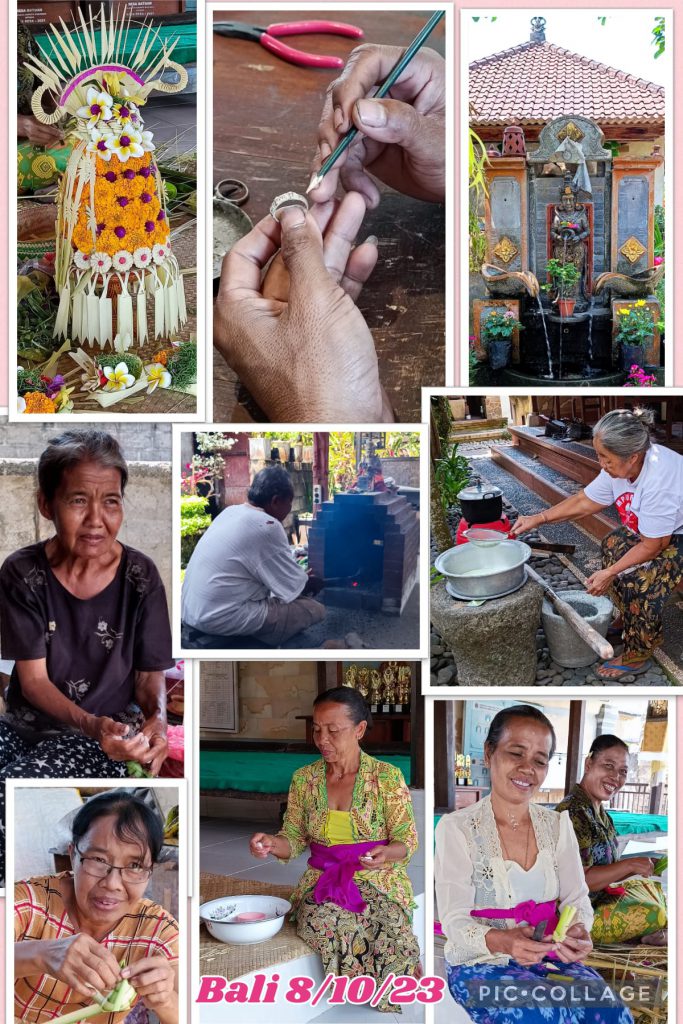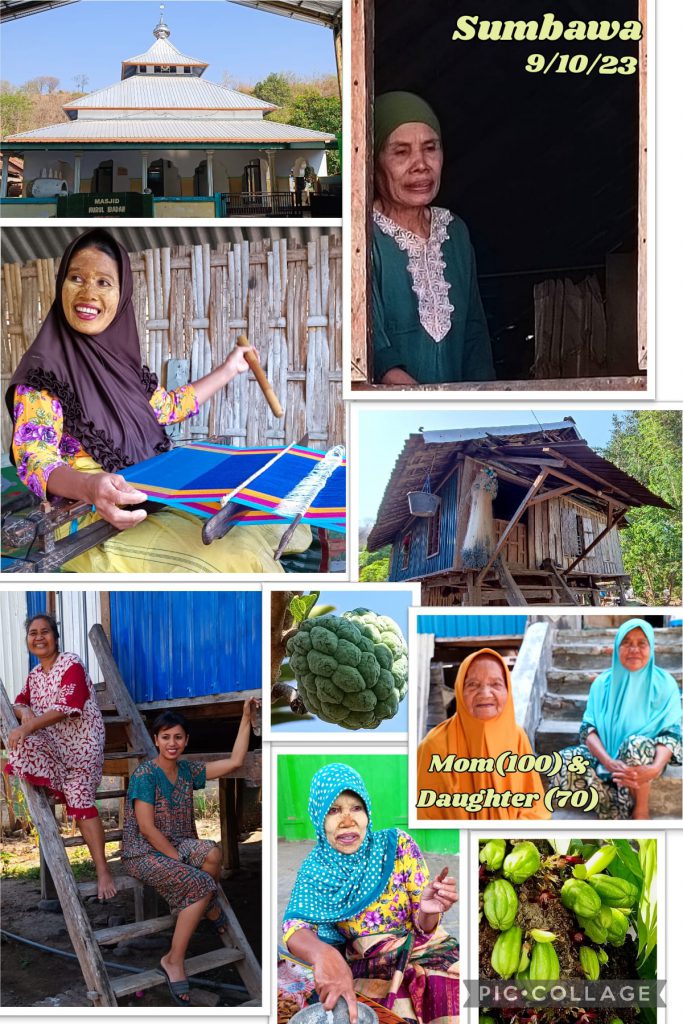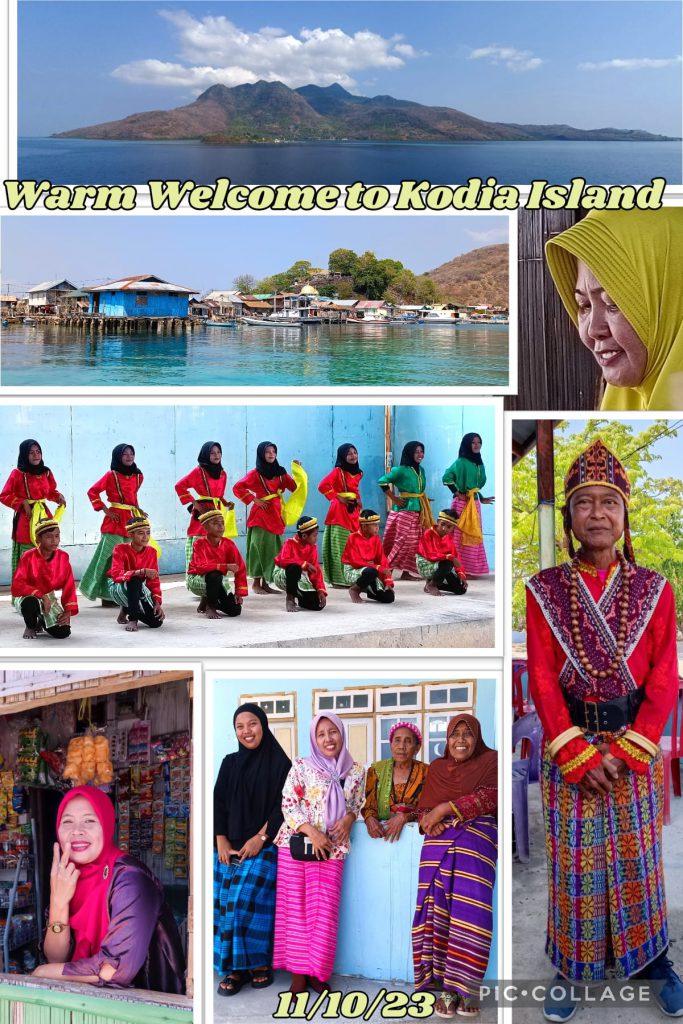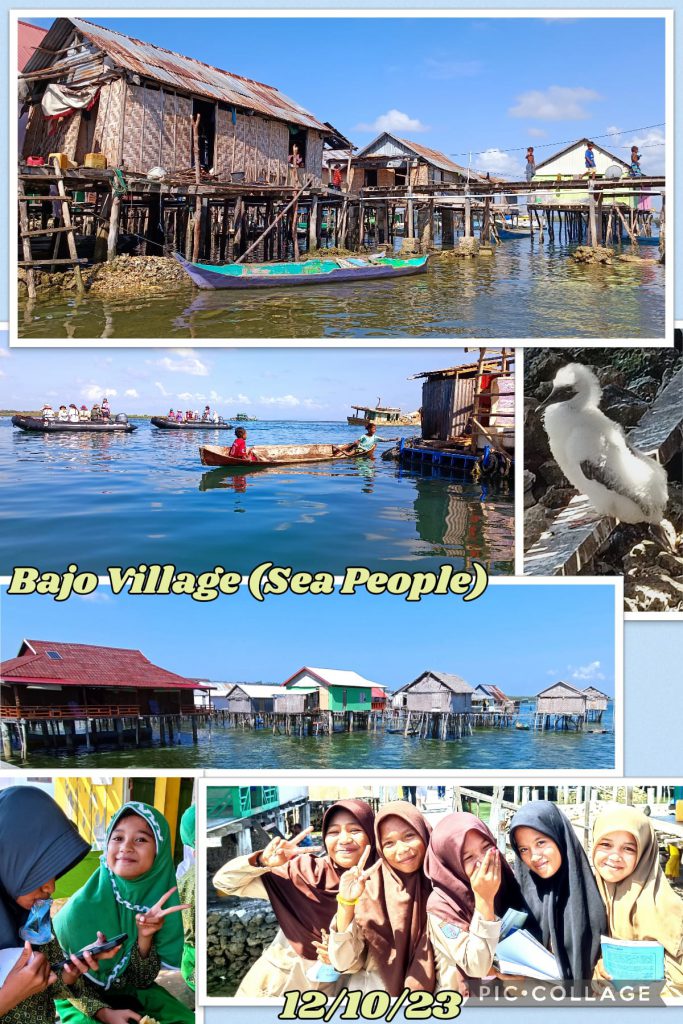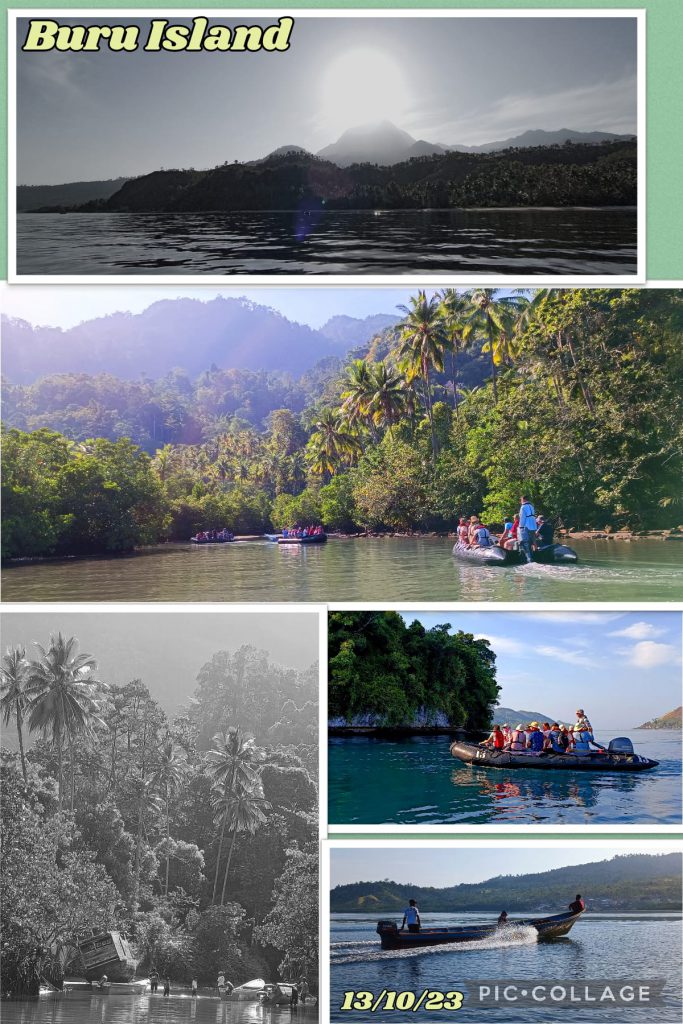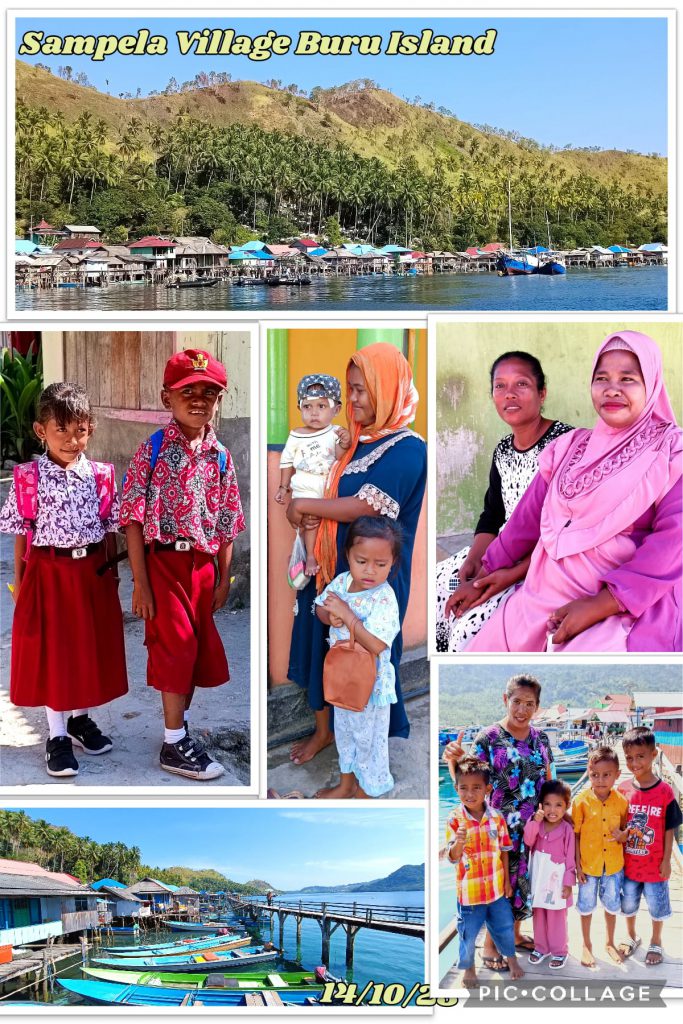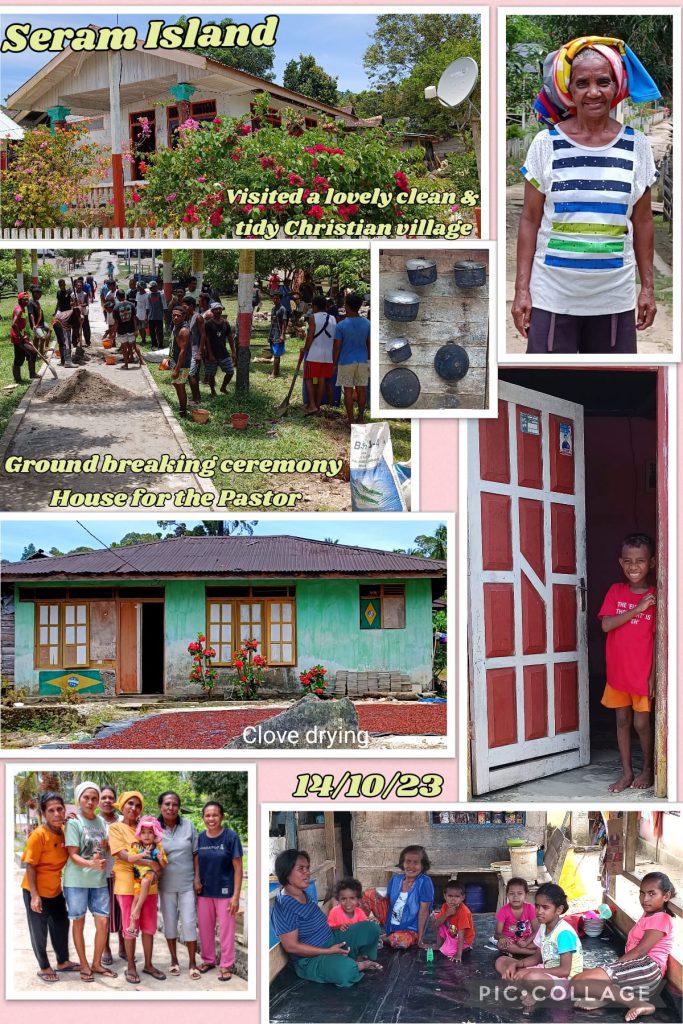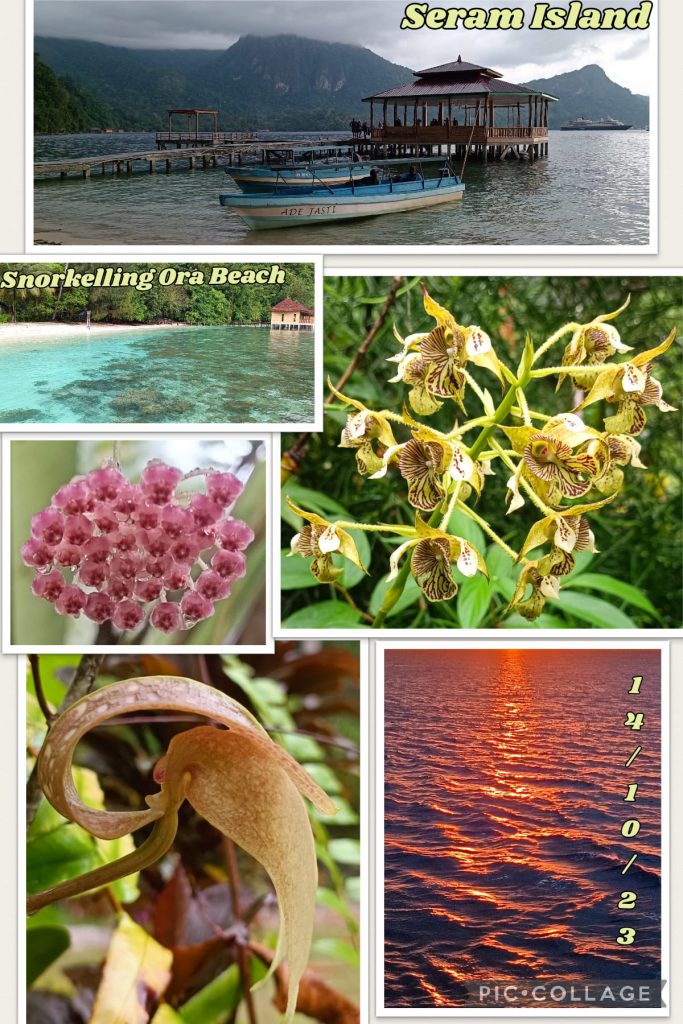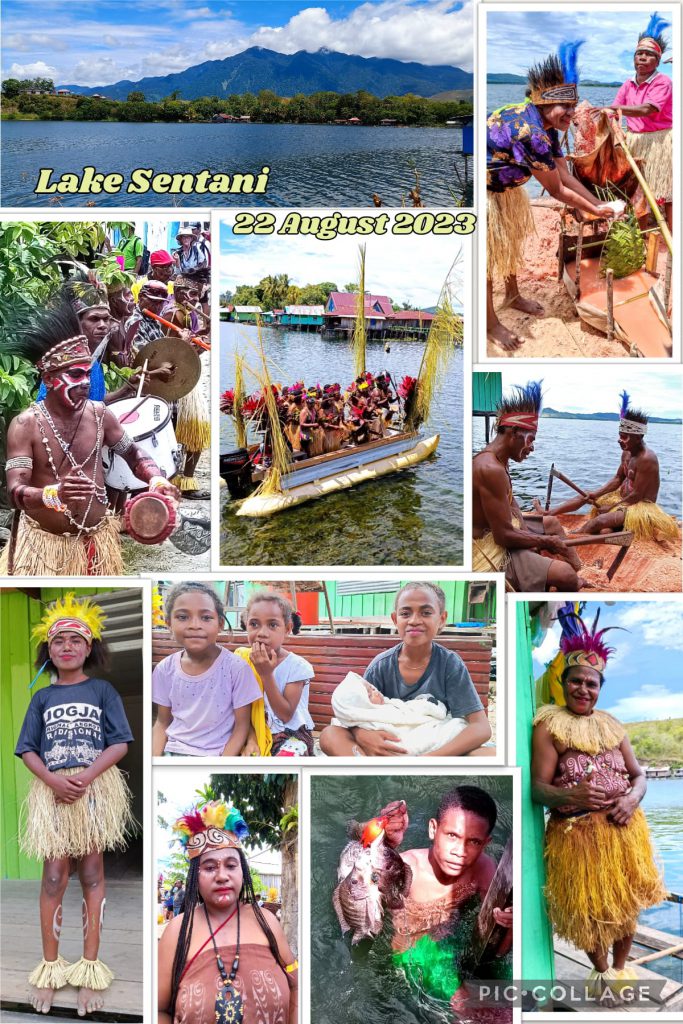Why Bali – Vanuatu on Heritage Adventure 2023
I had booked two expeditions with the Heritage Expedition to explore the coast of Sea of Okhotsk and Kamchatka in May-June 2020. COVID 19 threw the world upside down. A year later the Ukraine war made it impossible to visit Russia. I therefore switched to a one-month long expedition from Bali, Indonesia to the Papua New Guinea, Solomon Islands and Vanuatu comprising two legs I.e. Bali to Madang and Madang to Port-Vila .
As I was very busy with my studies and travel to Sydney and Sri Lanka, I did not have time to prepare. As a result, I made two mistakes. First, I redeemed my miles for a ticket to Bali. Without paying proper attention, I ended up spending some twelve instead of five hours to get to Bali via Kuala Lumpur, Malaysia. Second, I set off without an underwater camera missing the opportunity to capture the captivating marine life in the most pristine waters.
Bali – Madang Expedition (7 – 24 October 2023)
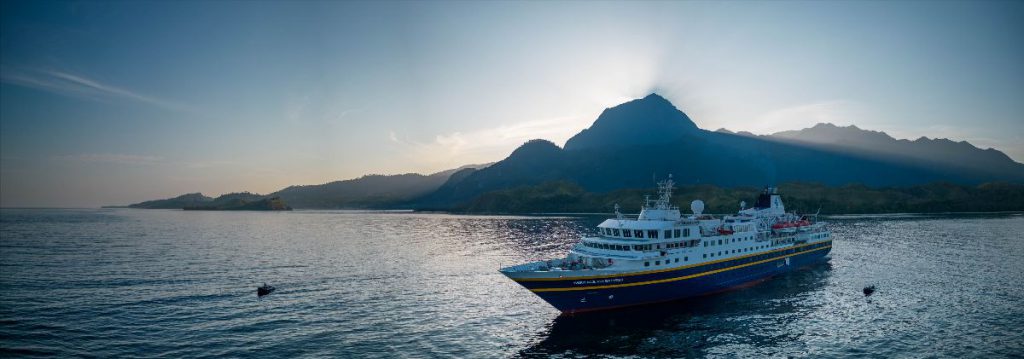
October 7 Saturday: I had to leave home before 6:30am to catch a flight at 9 am and eventually landed in Bali airport around 6 pm. I was late for the welcome dinner at the Hyatt Regency Hotel. The first people I met were Aaron (the expedition leader of the first leg) and Nathan (Aaron’s brother whom I first met during the Wrangle Island expedition and who would lead the second leg); Suzanne (the culture enthusiast), Sue and David from Adelaide. I was exhausted and had good sleep.
October 8 Sunday: There were over 60 passengers on the expedition. Before boarding the Heritage Adventure, my floating home for the next thirty days, I was arranged to join a short cultural tour to Lantangidung Village, a Balinese living compound surrounded by rice fields in Ubud. These Balinese villages nestled in green fields are charming, picturesque, and clean. We visited a few craftsmen who made offerings to deities with flower, flour and bamboo; were engaged in wood sculpture,silver and batik making and oil painting. We also visited Batuan Temple, one of the most beautiful within Tri Kahyangan Village. We had a nice buffet lunch in the Royal Pita Maha Maha Hotel before proceeding to the port for embarkation ready to set sail before sunset. As usual, we had to attend mandatory briefings. I shared a cabin on Level 3 (303) with Vivian and Nicki, both are from Brisbane. They are super nice.
October 9 Monday: Sumbawa Island & Satonda Island
The ship sailed through the Bali Sea and we arrived at Sumbawa Island in the province of West Nusa Tenggara with an area of over 15,000 km2 and a population of over 1.5 million. Our guides were thrilled to have their first group of tourists since COVID. We had a tour of the Pamulang Village which is tidy, simple and clean. All timber structures elevated above ground to permit water movements during monsoon season, are adorned with lovely plants. We were invited to visit one of the huts. Apart from a few mattresses on the floor and bowls and pans in the kitchen, there is not much else. Anyway, the people look happy.
Then we watched a water buffalo race where the rider perching on an A-frame structure behind two joined buffalos, had to race down a water-flooded rice paddy field while trying to steer them over a stick placed in the mud. Traditionally this event was a celebration at the end of the harvast, local entertainment and a fun way of tilling the muddy floor of the paddy. Thijs and Gavin from the boat joined the race. Many participants were unable to control the buffaloes, lost balance and fell off. The animal lovers were not pleased and considered the animals were cruelly treated.
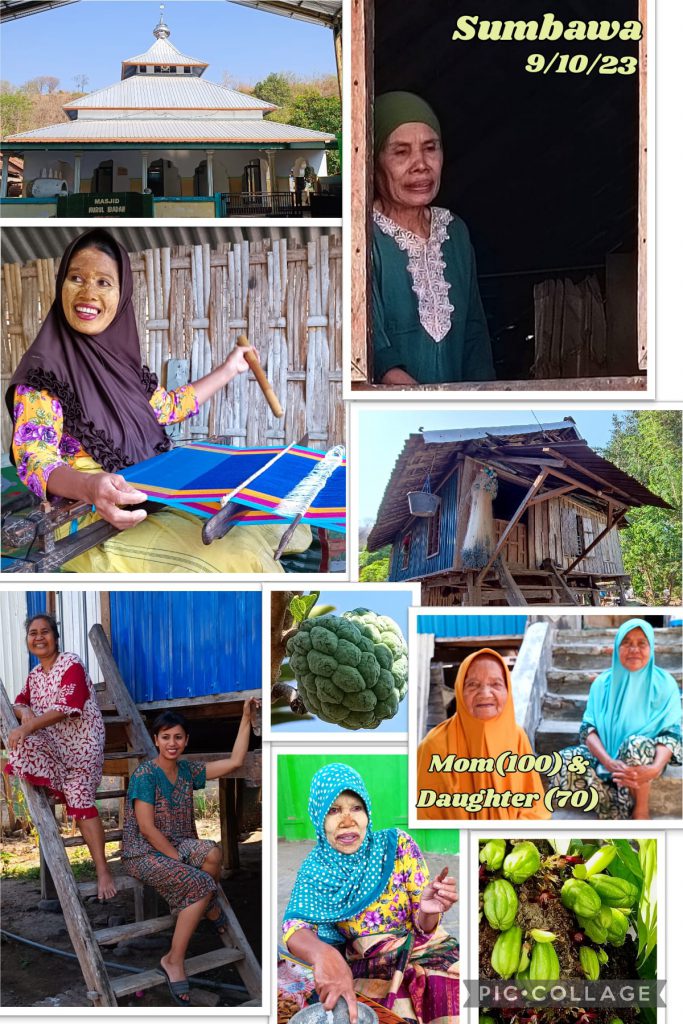
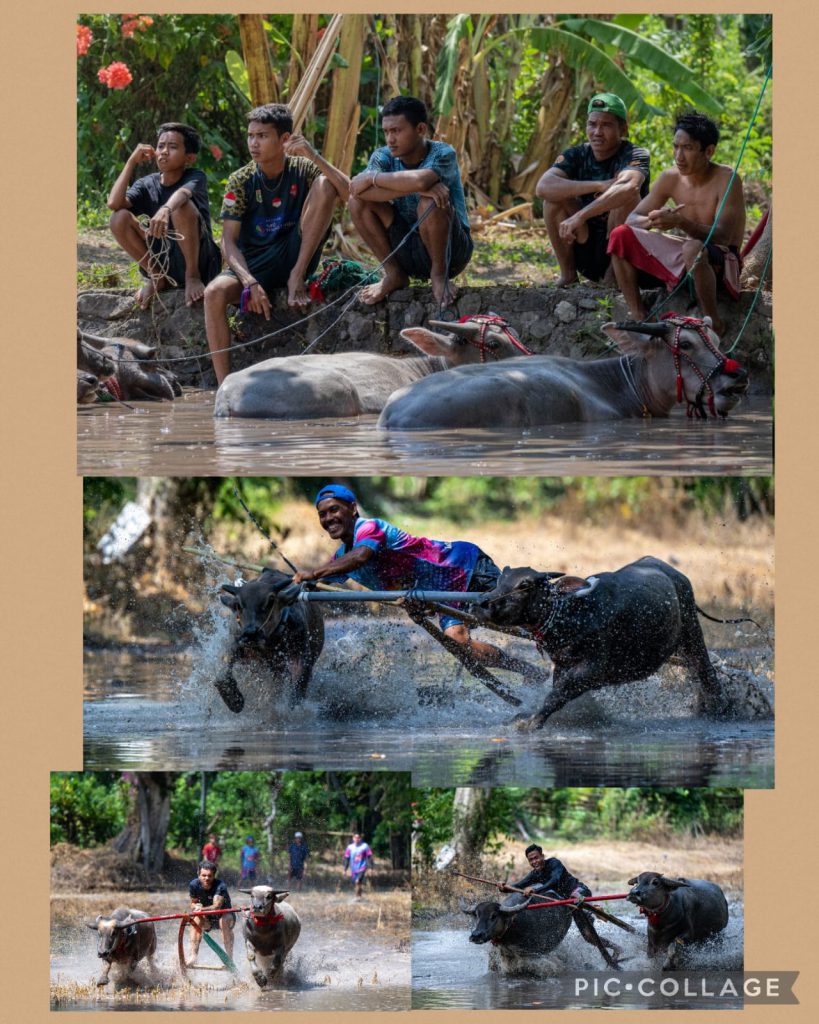
© Heritage Expeditions
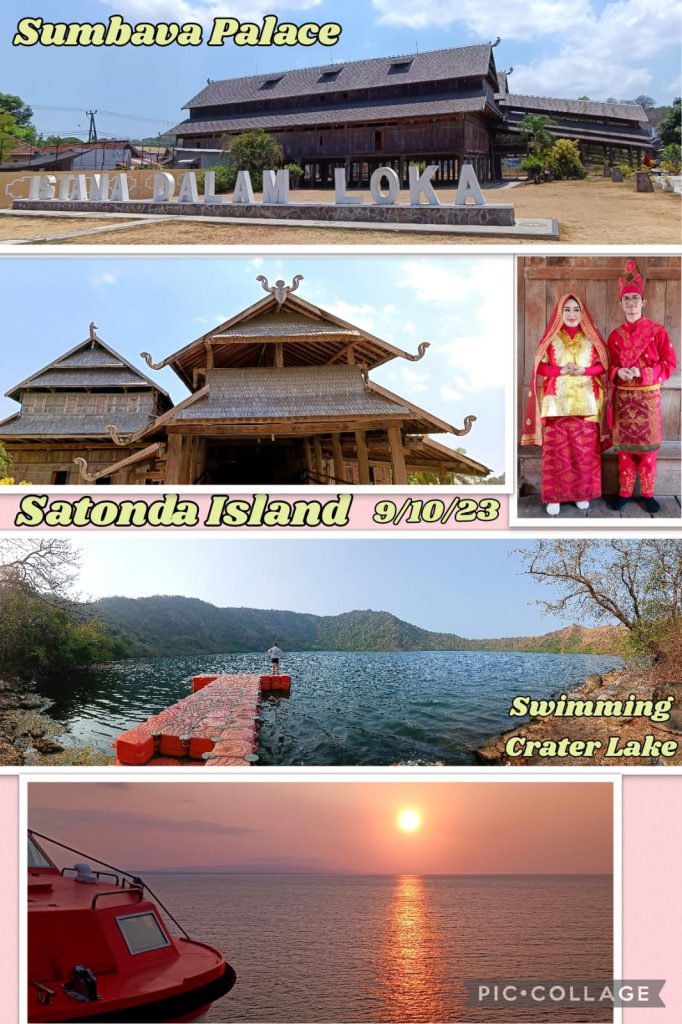
Our final stop was the iconic and impressive wooden Old Palace of Dalam Loka one of the largest wooden structures in the world. Dating from 1885 (during the reign of the 16th sultan of the Dewa Dalam Bawa Dynasty), it was made using wooden slotting joints and without any nails.
In the afternoon, we snorkeled and swam at the Satonda Island with a large crater lake in the center. I walked to the lake and had a dip before returning to the beach and snorkeled for an hour. I was delighted to watch a large lion fish for some 15 minutes: we looked each other in our eyes. Magical! I had my first snorkel of this expedition on 9 October. By the time I disembarked on November 8, I must have snorkeled over twenty times.
Marine Life
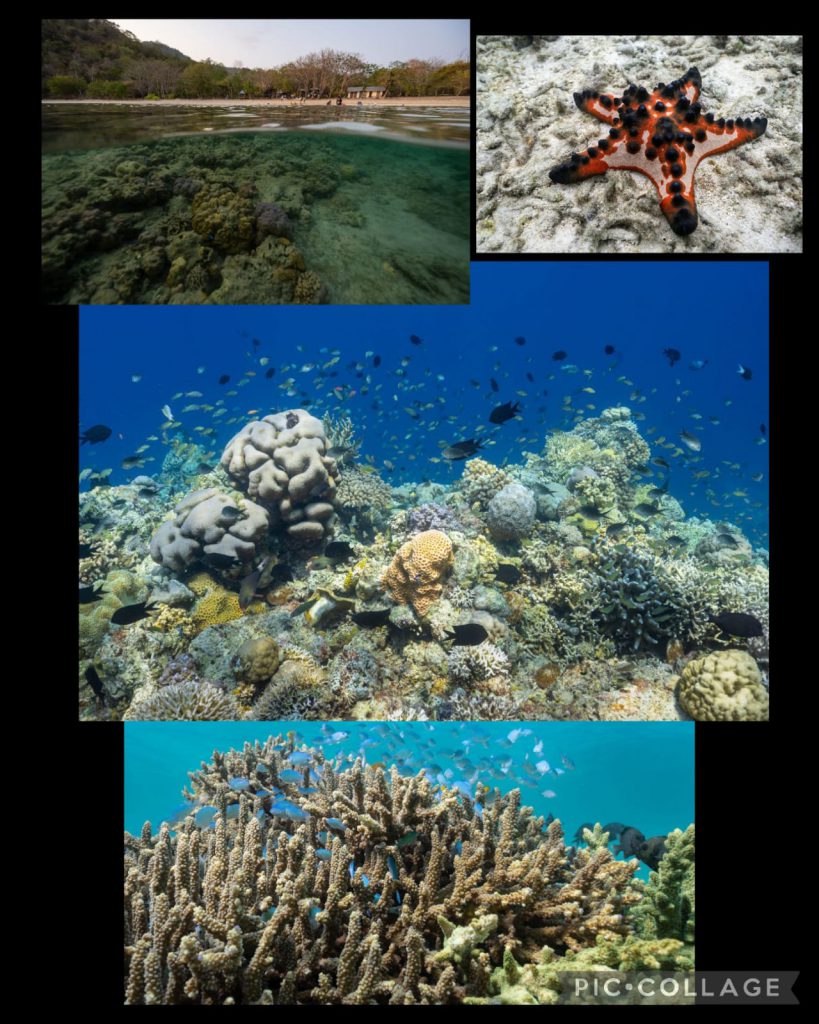
As of 2020, there are 2,175 identified separate coral species which can be classified as hard corals which form reefs by a calcium carbonate base with polyps with 6 stiff tentacles and or soft corals which are pliable and formed by a colony of polyps with 8 feather-like tentacles. I have seen plenty of hard (stony) corals- cabbage, lobed, table, boulder brain different colours, cactus, finger, star column, mushroom, elk-horn, stag-horn, cauliflower, whorls of chalice coral, pillar, tiered coral and cup coral. For soft corals, I can identify tan leather, Dendronephthya soft coral, sea fans, stinging Hydroid, mushroom leather, sea plumes, tree soft corals, spiral wire coral, sea whip etc. There are plenty of colourful sea worms (feather duster), sea slugs (Nudibranch), feather stars, sea urchin, sea cucumber, sea stars and tunicates.
October 10 Tuesday: Komodo Island & Pink Beach
We arrived at the Komodo Island with dry parched hills and a backdrop of a spectacular skyline of cones and ridges. It is the largest island in the Komodo National Park, an UNESCO World Heritage Site that I visited in June 2018 where I saw eleven Komodo Dragons (the largest lizard in the world). There are around 1,500 dragons on the island. I joined a birder group led by Frank, an ornithologist. In addition to seeing half a dozen dragons, I saw the Yellow Crested Cockatoos, Oranged-footed Scrubfowl, Tenggara Whistler, Flores White-eye, Flame-breasted Sunbird, Flying Lizard, and Green Tree Snails. In the afternoon, we snorkeled at the picturesque Pink Beach which I had spent a lovely afternoon during my last visit. The pink tinge is caused by Foraminifera, the shells of tiny marine creatures. I found the beach not as pink as before. But with snorkel gears, I could see the beach is full of soft and hard coral and tropical fish including Sergeant-majors, Butterflyfish and Clownfish.
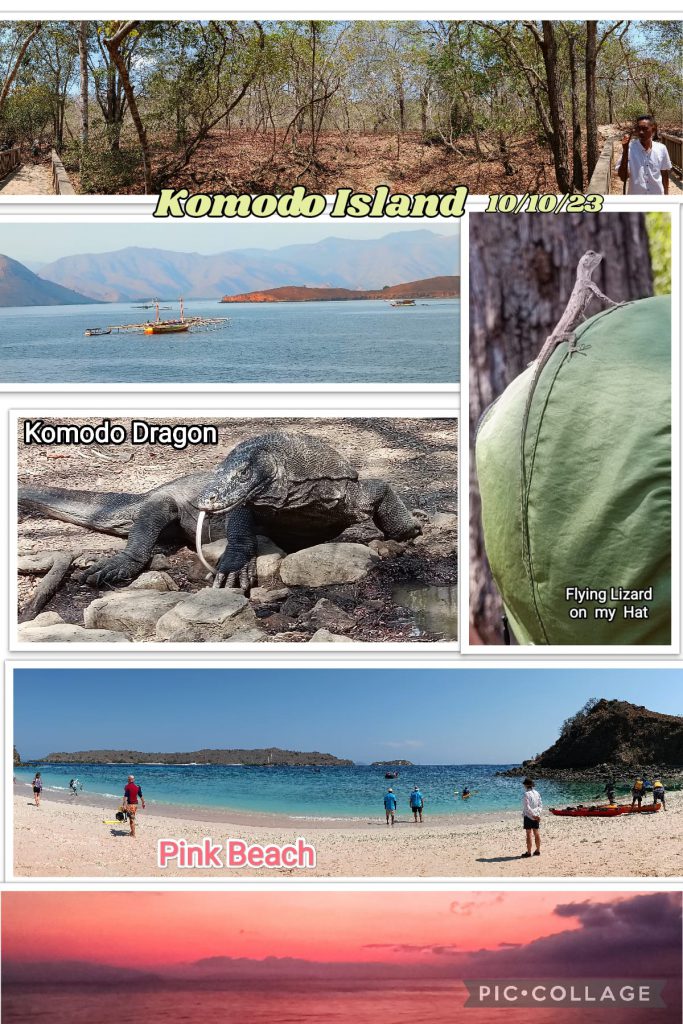
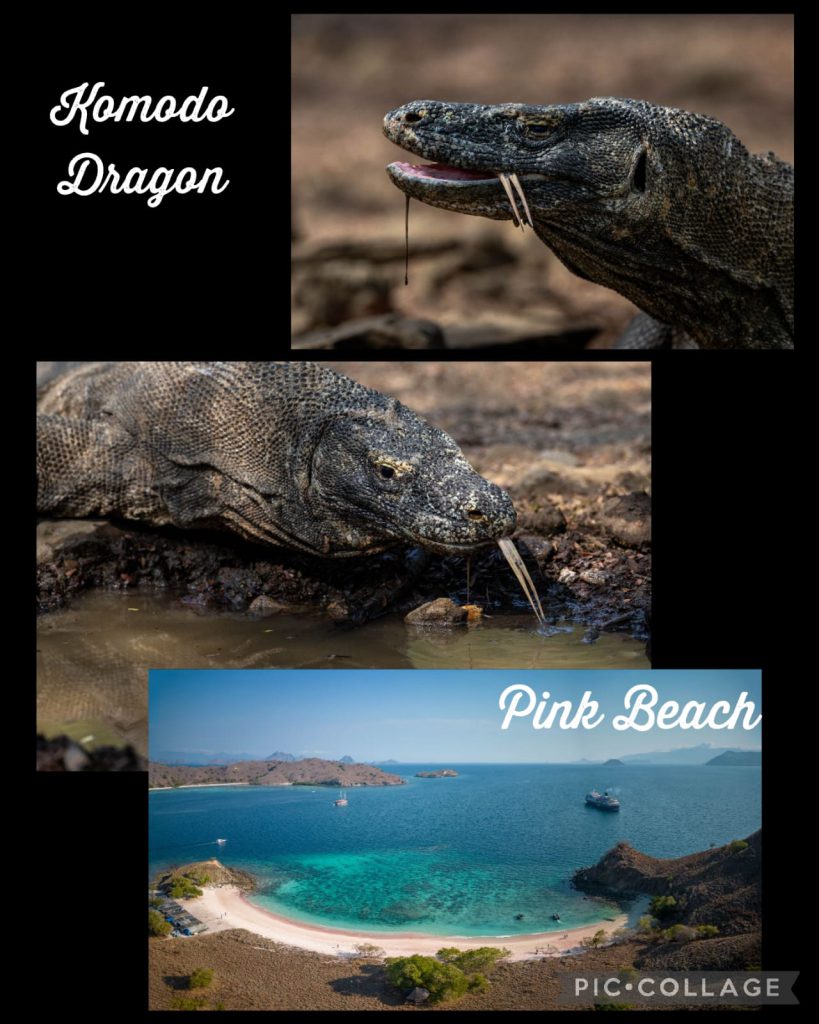
© Heritage Expeditions
October 11 Wednesday: Kodia & Koja Island
We reached Koja (a small village) to Kodia Island (the main island) along the northern coast of the Flores. We were by a group of school girls and boys with a welcome dance. The villagers enthusiastically showed us around the village which houses had been all destroyed by tsunami except a rocky top which is now a pilgrimage site (74 steps). From this vantage point, I had excellent views of the island, surrounding coral reefs and the 800-metre long causeway constructed by hand and opened in 1978 so that kids could walk to school on Kodia Island. The fit ones walked across the causeway to visit a school. As I am slow, I returned to the boat before 11 am in order to take a reef snorkel. The beautiful clear water with colourful coral is most impressive. But I did not see as many big fish as the day before. In the afternoon, we had three lectures on birds, tourism in Wakatobi and tidal passage. I always enjoy continuous education opportunities.
Thursday, 12 October Wakatobi and Hoga Island
I had my first sight of the bajo (sea gypsies/once nomadic sea dwellers) on the Hoga Island, Wakatobi. The village has a Muslim population of over 2,000 whose wooden huts are built on stilts. Sanitation is poor: all human waste goes to the sea. We had an interesting zodiac cruise where we could observe the locals carrying on their daily life. We then walked around the village and I was glad to find a simple but clean clinic. I also met a group of teenage girls who looked cheerful and happy.
We had wonderful time snorkelling on the Kaledupa Island Reef with seagrass and abundant marine life: large Chocolate Chip Sea Stars, hard and soft corals, giant clams, Anemones (clown fish), Christmas Tree Worms. I did see lots of colourful coral fish and impressive massive corals.
In the afternoon, we had a good lecture by Frank on birds and another by Courtney on marine life.
October 13 Friday: Buru Island
I watched sunrise over the soaring peak of the Buru Island, the third largest island within the Maluku Islands. It was only the third time the island was visited by an expedition boat. Religious affiliation is evenly split between Christianity and Islam. It was occupied by the Japanese during WWII and former president Suharto built a prison holding thousands of political prisoners during his New Order administration in the 1960s-1970s.
As I did not feel and sleep well (possibly because of the swell), I vomited twice before breakfast. Though I was not in top form, I participated in the land programme after a zodiac cruise along the limestone coast of Buru. We explored the mangroves, saw large freshwater springs erupting from the limestone cliffs and underwater, as well as dense canopies. The morning lights were magically.
Then we landed in the Pasir Putih Village where we were greeted warmly with welcome dance. Local guides showed us the village. Houses are built on land in bricks and cement as well as traditional bush materials. There are also some houses built on stilts. The village seems well-provided with wells and water taps. I noticed the change of architectural styles of the houses. (Correction: The photo above should be Pasir Putih Village on 13/10/23)
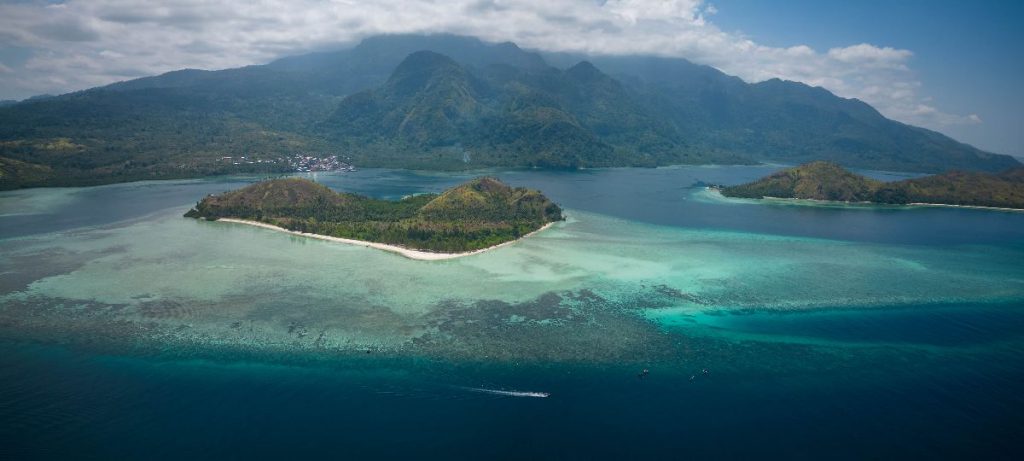
We snorkeled off the Bird Island before lunch. When the expedition team learned about my nausea and vomits, they whisked me off to isolation for 24 hours (Room 423). I later learned that several passengers had problems gastro problems. For precaution, they isolated anyone with symptoms though I was quite sure that my nausea was probably due to the sea conditions and lack of sleep. Anyway, I enjoyed the temporary solitude and had a good sleep.
October 14 Saturday: Seram Island
Today, the boat made an inaugural visit to Seram Island with an early morning excursion to a low land forest in the Manusela National Park followed by village visit. As I was in isolation, I could only watch others getting off the boat! Around 10 am, I asked the onboard doctor to release me from isolation. After checking, she allowed me to come out of the room. Unfortunately, as all the expedition staff were in the park and out of reach of the radio, I had to wait till noon when the first zodiac took passengers back to the boat. I was glad that I still had some 40 minutes roaming freely in the tiny Rumah Olatto Village where I saw an Ebenezer Church, the first church I saw during this journey. The village with some 100 families and 400 people, is super clean and tidy. Apparently, the owner of the resort, a supporter of the church and the village is building a new house for a pastor.
In the afternoon, we snorkeled at an Eco Resort where we found several endemic orchids and plants. Corals are not as extensive and spectacular as previous days: some seemed to have been destroyed by storm. Suzanne gave a fascinating lecture on the Sultans of Spice. I watched the best sunset since we set sail.
October 15 Sunday: Misool Island, Raja Ampat
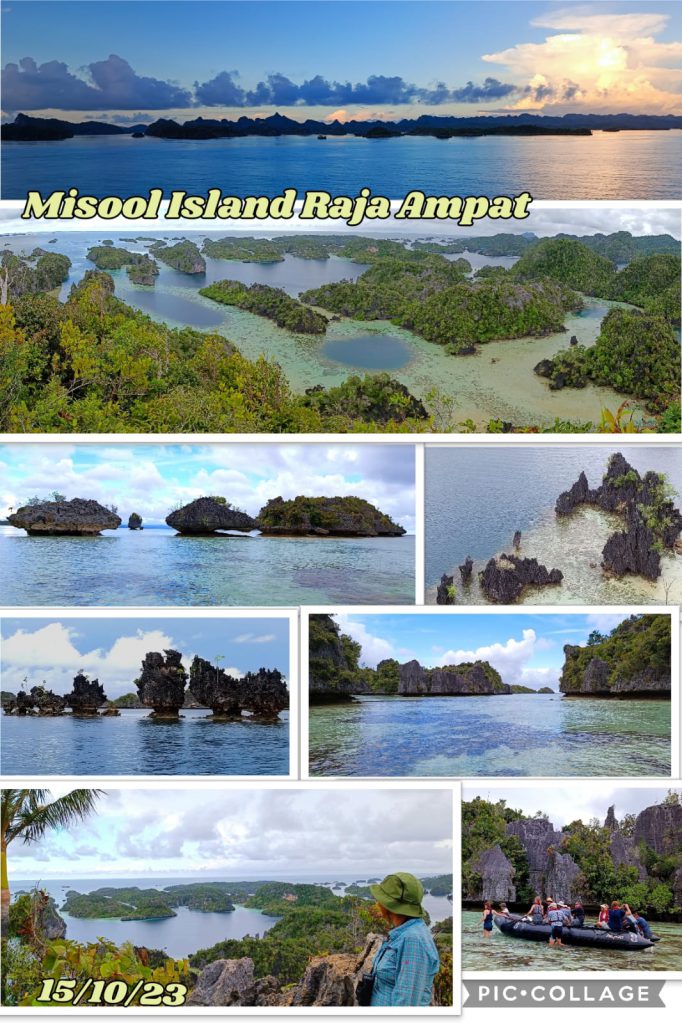
Located off the northwest tip of the Bird’s head Peninsula on the island of New Guinea, Raja Ampat is an archipelago with an area of 70,000km2 comprising over 2,700 islands, cays, and shoals surrounding the four main islands of Misool, Salawati, Batanta and Waigeo. The land area is just over 8000 km2. The archipelago straddling the Equator and forming part of the Coral Triangle covers the tropical waters around the Philippines, Indonesia, Malaysia, Papua New Guinea, the Solomon Islands and Timor Leste. It contains the richest marine biodiversity on earth with at least 500 species of reef-building corals in each eco-region.
I watched a beautiful sunrise when the ship was approaching the Misool Island, the second-largest island in the archipelago. We began by exploring the iconic karst landscape labyrinth of islets formed from uplifted and undercut coral limestone by zodiac before 7:30am. It was nice and cool with an overcast sky.
The crystal blue lagoon dotted with strange mushroom-shaped eroded limestone formations was atmospheric. Hundred of terns rest on a rock-outcrop at the entrance of the lagoon. As the tide was low, zodiac drivers had to jump into the water to pull the zodiac through. The topography reminds me of Ha Long Bay in Vietnam. We discovered two Sumalelen ancient rock art painting (3,000-5,000 years old) of a hand in ochre on a rock. It depicts the vessels and lives of this early sea culture.
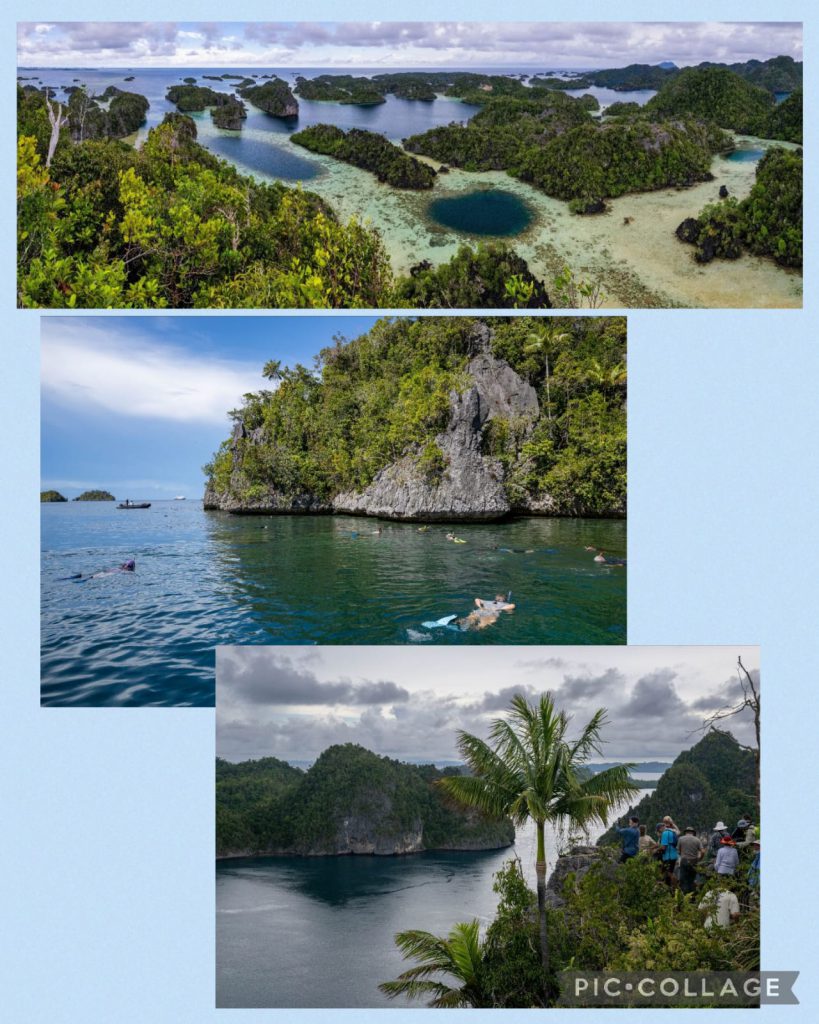
© Heritage Expeditions 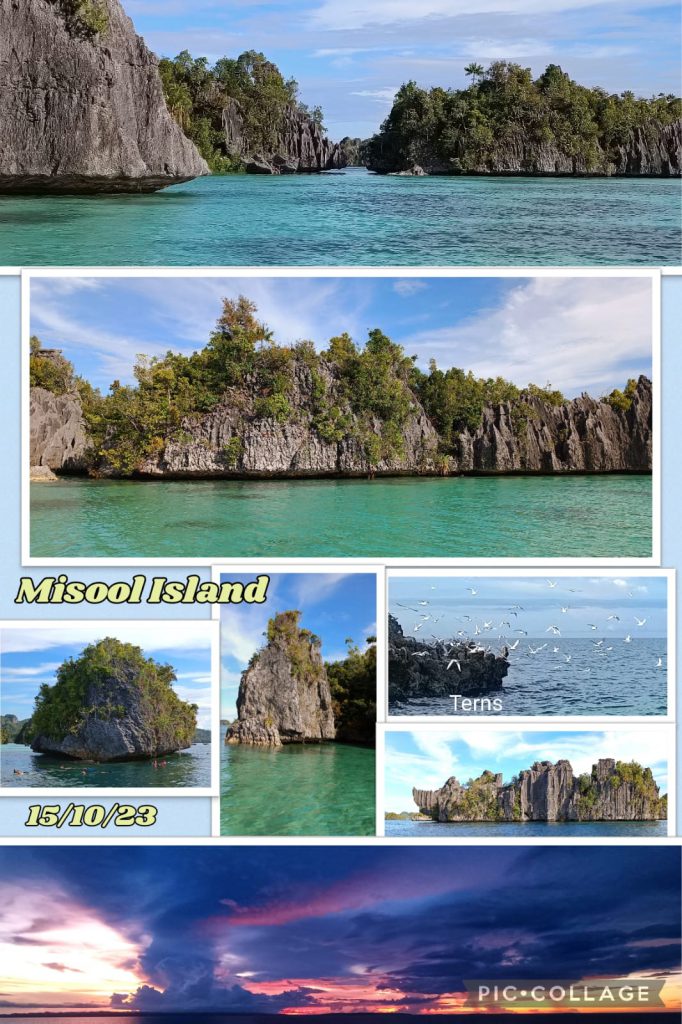
We landed on the island where Dapunlol Peak (100m) stands. I took a steep climb on a purpose-built staircase with 236 steps to the peak from where I could see the primordial pool adorned with impressive karst formations and lush Pandanus and Betel Palm vegetation hanging onto near-vertical landform.
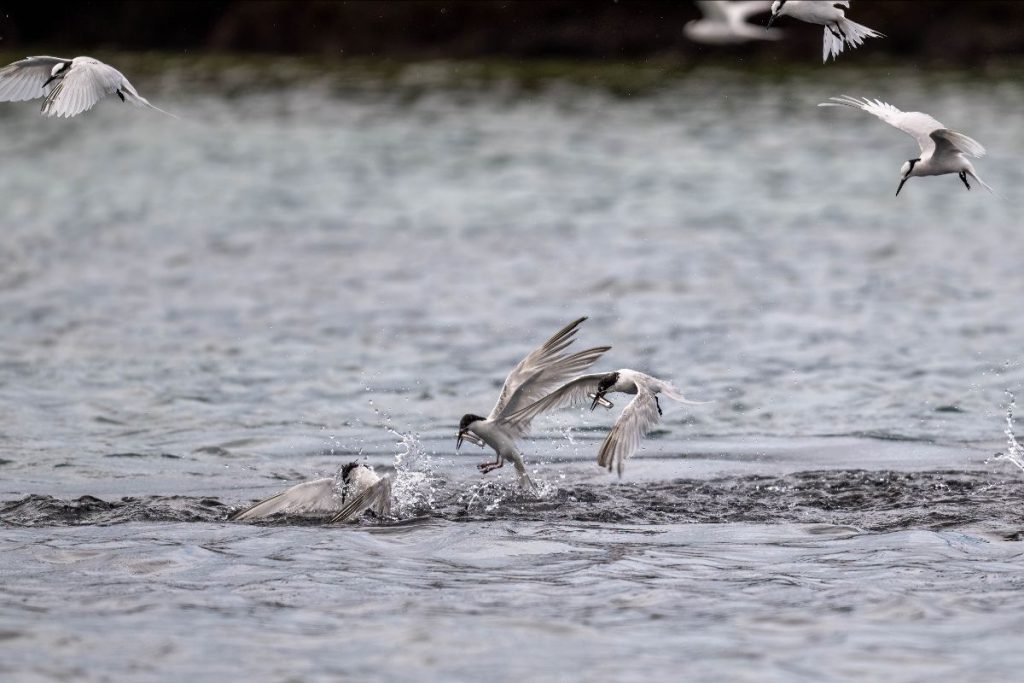
In the afternoon, we snorkeled along the base of a short stretch of the limestone formations with a sheer drop to our left. I saw many dead corals, some orange jelly fish, star fish and coral fish. The sea ferns were pretty and gigantic. On the way back to the ship, Lou, our zodiac driver who was a former director of conservation in New Zealand, took us on a scenic cruise of the azure lagoon. We got close to a rock outcrop with hundreds of terns. This is the best zodiac cruise of the expedition.
October 16 Monday: Wayag Island, Raja Ampat
We crossed the Equator around 5:30 am and arrived before sunrise at the Wayag Island, the jewel in the crown of Raja Ampat. We explored this stunning area dotted with uplifted sugar loaf bare rock Islands with lust vegetation. I was delighted to a large mantra ray gliding close to the zodiac.
We found a white sand beach. While the fit adventurers climbed the steep Mount Pindito (760m) that offers unrivalled panoramic views, I snorkeled off the beach and began to notice more marine creatures and life in the sandy bottom including a colony of Giant Clams. The Staghorn Coral looked very healthy resembling a forest.
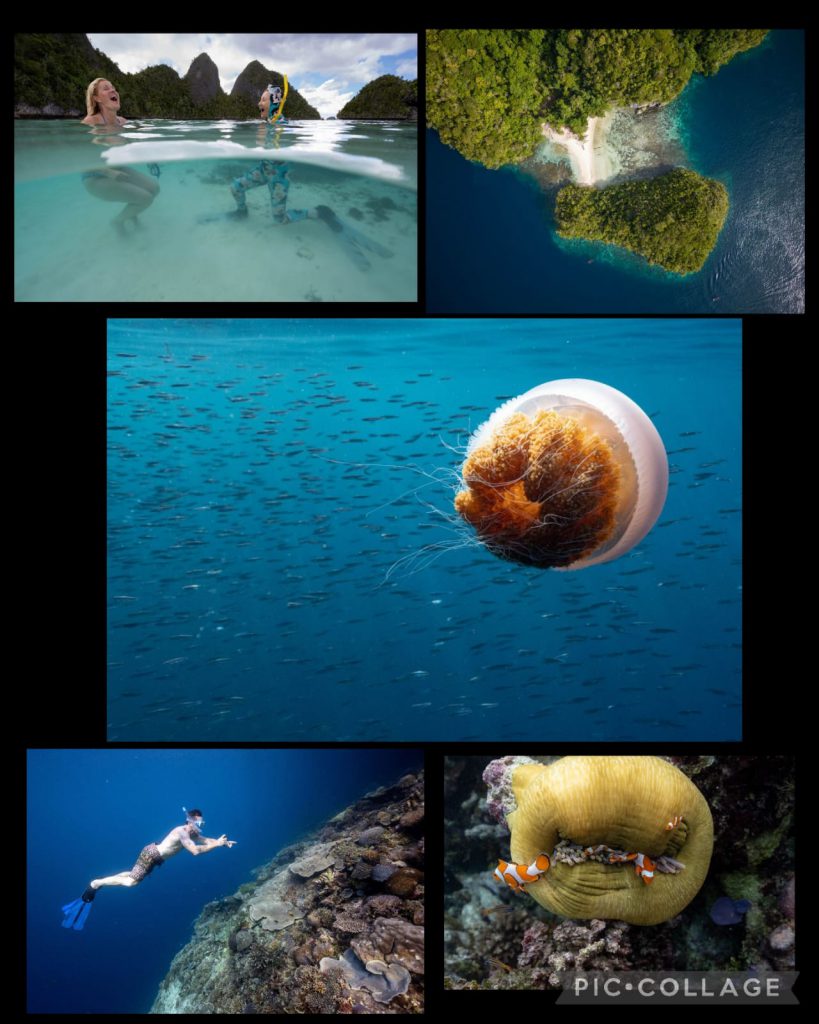
© S. Bradley, Heritage Expeditions 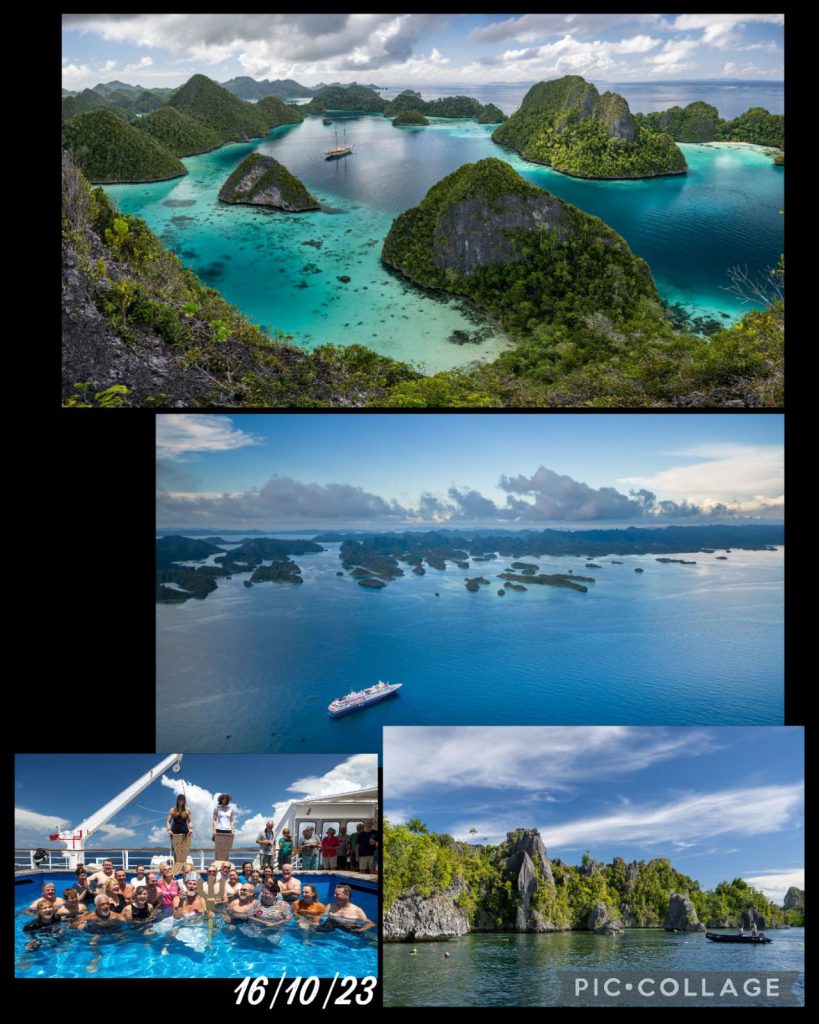
© S. Bradley, Heritage Expeditions
Around 1 pm, we crossed the Equator heading south. The Polliwogs (sailors who had not crossed the Equator) went through a ritual and blessed by Neptune in the pool. (I am a Shellback after having undergone the same ceremony during my expedition from Ushuaia to Cape Verde in May 2015). © S. Bradley, Heritage Expeditions
We spent a wonderful afternoon snorkeling around the Aluji Bay. Corals are rich in both variety and colour. We snorkeled off the beach along the base with a shallow end that drops rapidly to a great depth. There were large schools of fish. We had a great day ending with a BBQ dinner on deck.
October 17 Tuesday: Waisai, Waigeo Island, Raja Ampat
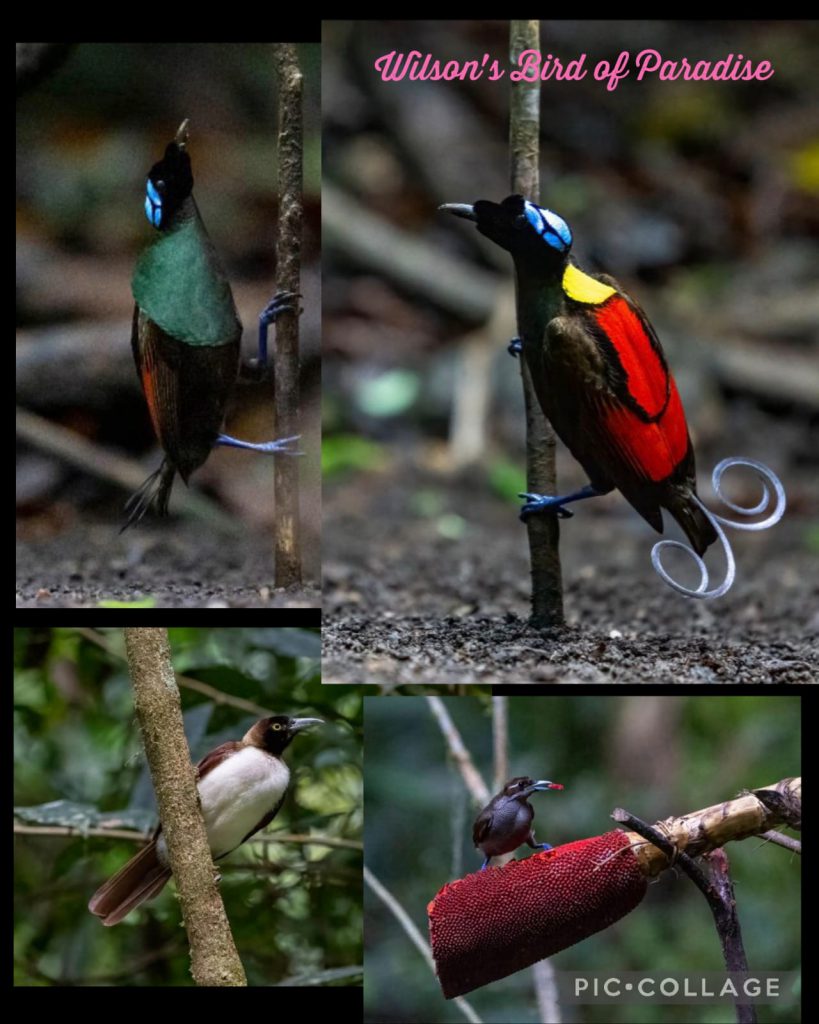
We went ashore at 4:30am at Saporkrena at Waisai on Waigeo Island in order to catch a glimpse of two out of the 39 species of Bird of Paradise (BoP). I joined the majority going to look for the Wilson’s BoP. Over 40 of us squeezed into a large hide and watched the bird that hopped up and down some five to fifteen metres in front of the hide. As I arrived late and was at the third row, I did not see much. When those sitting in the front row left, I moved to the front row with a good view of the bird that is magnificent and colourful. But it threw off after a few minutes. Rod, our naturalist said the bird might return in 20 minutes or an hour later. At this point, I decided to leave. A handful of people stayed on and awaited over an hour before the bird reappeared. They were handsomely rewarded with full view of the bird in beautiful morning lights.
The second group with about 15 participants had a steep and longer climb. They were able to spot five male Red BoP at the top of the canopy. The plume of this bird is gorgeous. We were all back on the ship around 11 am.
In the afternoon, we snorkeled before attending great lectures on the Secrets of Photography by Steve and Dispersal of Species by Rod.
October 18 Wednesday: Manokwori & Arfak Mountain
We had our second bird-watching morning at the Arfak Mountain. We went ashore at 3:30 am, and travelled for an hour to an altitude of 1,500m in a fleet of Hilux 4WDs into the mountains in search endemic birds. I was in a 4WR with three keen birders. As a result, we visited four hides and watched two rarely observed Black-billed Sicklebill, two Magnificent BoP, a large roofed maypole bower built by a Vogelkop Bowerbird (there are 20 species of Bowerbirds). We returned to the boat before 1 pm.
We were exhausted after two bird-watching days. In the afternoon, I attended lectures on birds and WWII. Bruce told the audience about the sad history of the Japanese Cave in Biak where over 3000 Japanese soldiers had died when the US forces bombed from above and poured petrol into the cave while Frank talked about the Recovery of Tropical Rainforest.
October 19 Thursday: Swimming with Whale Sharks
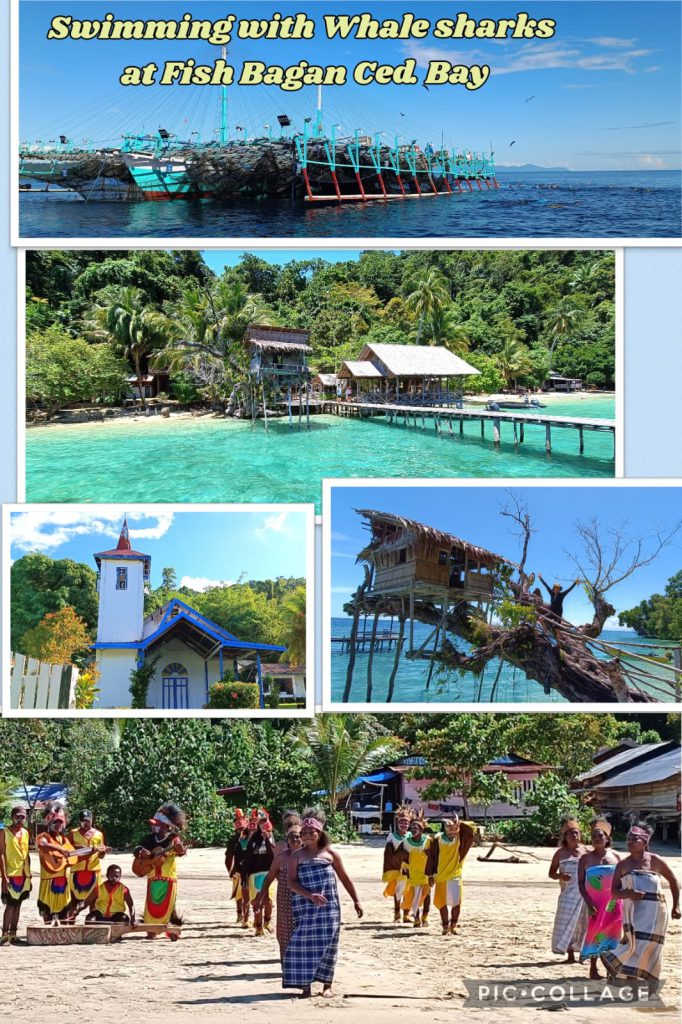
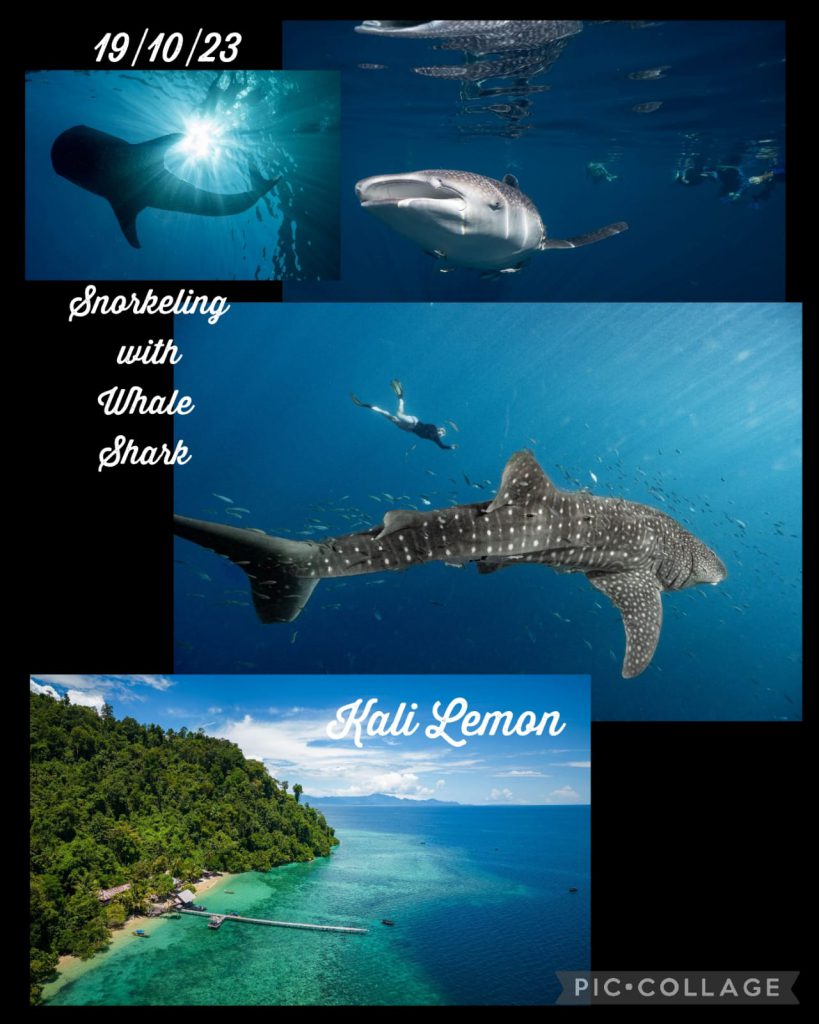
© S. Bradley, Heritage Expeditions
We reached the Cenderwasih Bay in early morning. From 7 to 9am, we had three rounds of swimming with five Whale Sharks that are attracted by left-over fish near a fish bagan at the bay. We had great fun! There were dozens of Greater and Lesser Frigatebirds dived to the water surface with precision aerial agility. From 10 am to 12 noon, we snorkeled near the Kali Lemon Dive Resort. Here we saw sea cucumbers, some Giant Clams and a reef with a variety of colourful hard corals and small fish. In the afternoon, we visited the Kwatisore Village, where we had a traditional welcome with a Bird of Paradise Dance. Once onboard, Abam gave a lecture on conservation efforts in Raja Ampat as well as the whole region by the Indonesian, Philippines and Papua New Guinea in order to preserve fishery (an important protein for the population) and biodiversity.
October 20 Friday: Biak
We first went to the Japanese cave site which has a small museum. We entered the cave surrounded by tangled jungle through a huge hole in the rock. I find the the dark cavern penetrated by morning lights atmospheric. A few musicians playing traditional instruments in the dark further created a mysterious and sad set-up for the visit though there was nothing in the cave to remind visitors of the death of the soldiers some 70 years ago. Apart from the cave, there is a small museum with weapons and other artefact including a collection of skulls and bones of some of the victims recovered from the cave.
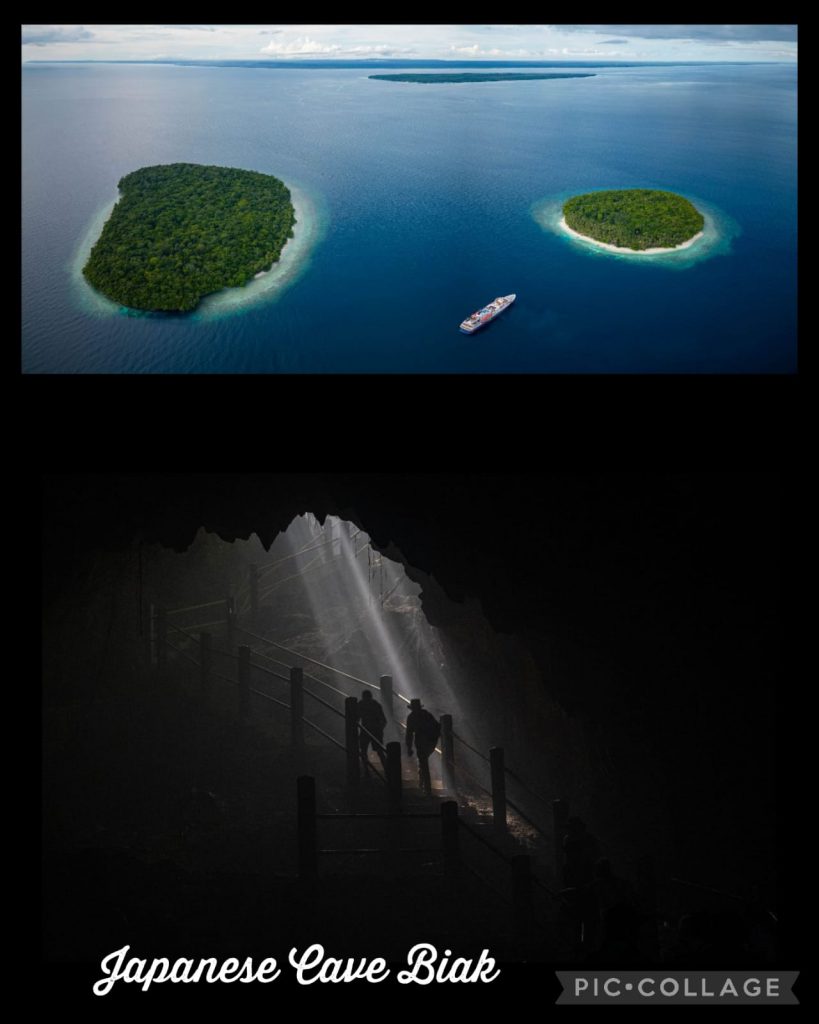
© S. Bradley, Heritage Expeditions 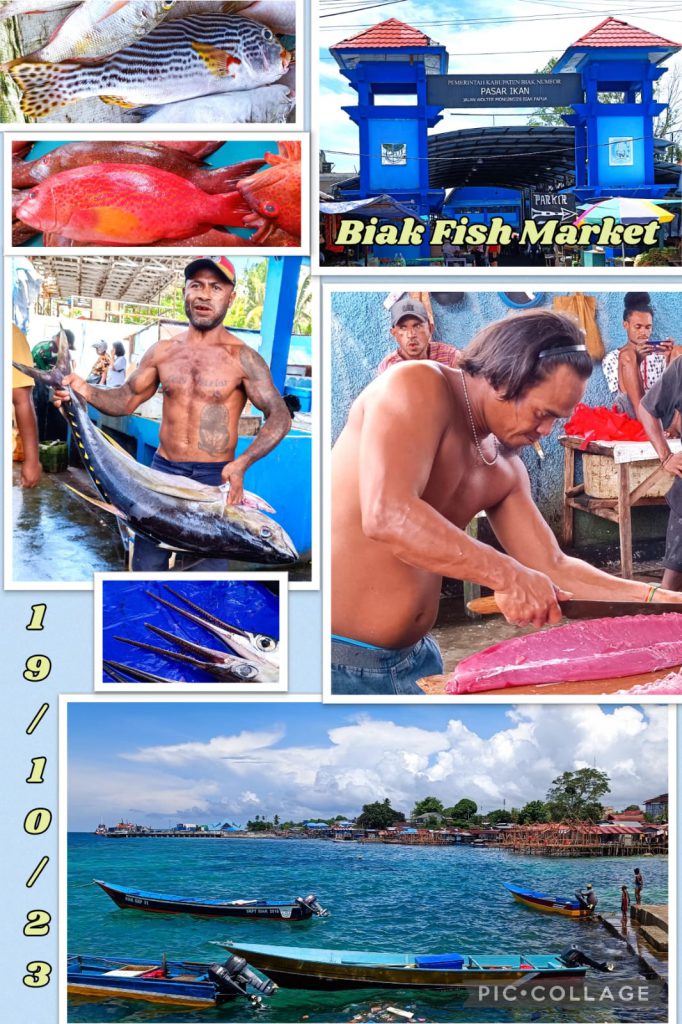
On the way back to the boat, we stopped at a neat fish market. I spent an hour there looking at a great variety of fish of the day. The fish stalls were not smelly at all. The chef of the boat bought ten tuna in the market (USD100 for each tuna). This is indeed a good way to support the local economy.
After lunch, we headed off to the Rusbasbedas Island owned by two families. They are building a concrete path around the island. I think the existing path with dead coral is adequate and brands in well with the rustic atmosphere of the island. I took a nature walk with Rod before snorkeling off the beach. I saw plenty of coral fish. The hotel staff set up a bar on the beach and offerred guests with champagne and non-alcoholic drinks!
October 21 Saturday: Liki Island
We had a wonderful time in Liki Island, which is part of the Koemamba Islands. We were surprised to see a full turnout of 400 villagers from 68 families along with officials from West Papua. The head of the village greeted us as we stepped on shore and pressed some of the sand across our forehead to ground us to the new place. We were given hats made with young coconut leaves and flowers. I was among the last group of passengers to land and was greeted with a tropical downpour of half an hour. We took shelter in local houses and verandas. The local ladies who sang and dance despite the rain, were joined by some of the group members. It was a great experience!
When the rain stopped, the Minister of Tourism of the local agency and the village head gave a welcome speech. We then toured the village and viewed artwork from a local school and the basketry of the local women. We tried the sago palm and fried fish.
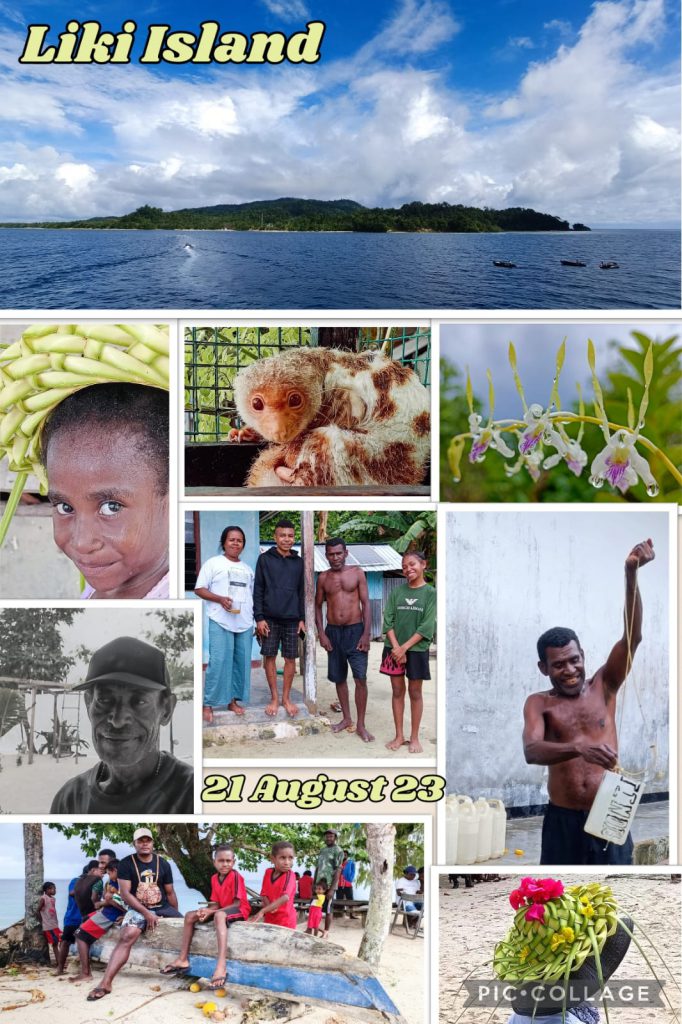

© S. Bradley, Heritage Expeditions
By 10:30am, most of us returned to the boat to get ready for the last snorkel of the expedition. I enjoyed the slow drift snorkel in a small cove. The highlight today was the swim with two cuttlefish for over ten minutes. We also saw feather duster worms, angelfish, wrasse and the endangered Blue Coral. In the afternoon, we had lectures from Rod on wildlife photography and Fiona on her sculpting practice.
October 22 Sunday: Jayapura & Lake Sentani
It was our last day in Indonesia. The boat entered the port of Jayapura, the capital of Papua at dawn. After breakfast, we boarded a coach with police escort. Our first stop was the Museum Loka Budaya which has a fascinating collection of cultural artefact from the Papuan region including masks, shields, and weapons. We spent almost an hour in the museum.
We continued our ride to the Yobe village by Lake Sentani located among the verdant hills of the Cyclops Mountains Strict Nature Reserve. We were welcomed to this village by a group of local children performing their canoe dance. We walked across a boardwalk following a marching band. Locals put wares on sale outside their huts as well as demonstrated carving and sago production for us.
We were back on board by 1pm and got ready to leave Indonesia for Vanimo in Papua New Guinea (PNG) for custom clearance. We sailed across the border which is only marked with a lighthouse on the coast, around 3:30 pm. Frank gave a lecture on birds and Bruce on the Role of PNG and Guadalcanal in the Pacific War.


